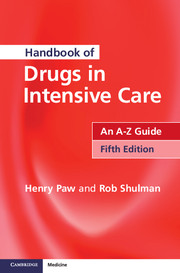Book contents
- Frontmatter
- Contents
- Introduction
- How to use this book
- Abbreviations
- Acknowledgements
- DRUGS: AN A–Z GUIDE
- SHORT NOTES
- Routes of administration
- Loading dose
- Drug metabolism
- Enzyme systems
- Drug excretion
- Drug tolerance
- Drug interactions
- Therapeutic drug monitoring
- Target range of concentration
- Pharmacology in the critically ill
- Cardiopulmonary resuscitation
- Drugs in advanced life support
- Management of acute major anaphylaxis
- Management of severe hyperkalaemia
- Management of malignant hyperthermia
- Sedation, analgesia and neuromuscular blockade
- A practical approach to sedation and analgesia
- Opioid Conversion table
- Management of status epilepticus
- Prevention of delirium tremens and alcohol withdrawal syndrome
- Prevention of Wernicke–Korsakoffsyndrome
- Anti-arrhythmic drugs
- Inotropes and vasopressors
- Bronchospasm
- Anti-ulcer drugs
- Immunonutrition in the ICU
- Corticosteroids
- Short synacthen test
- Bone marrow rescue following nitrous oxide
- Antioxidants
- Post-splenectomy prophylaxis
- Anti-microbial drugs
- Bacterial gram staining
- Antibiotics: sensitivities
- Renal replacement therapy
- Extracorporeal drug clearance: basic principles
- Drug doses in renal failure/renal replacement therapy
- Chemical pleurodesis of malignant pleural effusion
- APPENDICES
- DRUG INDEX
- IV COMPATIBILITY CHART
Renal replacement therapy
Published online by Cambridge University Press: 05 November 2014
- Frontmatter
- Contents
- Introduction
- How to use this book
- Abbreviations
- Acknowledgements
- DRUGS: AN A–Z GUIDE
- SHORT NOTES
- Routes of administration
- Loading dose
- Drug metabolism
- Enzyme systems
- Drug excretion
- Drug tolerance
- Drug interactions
- Therapeutic drug monitoring
- Target range of concentration
- Pharmacology in the critically ill
- Cardiopulmonary resuscitation
- Drugs in advanced life support
- Management of acute major anaphylaxis
- Management of severe hyperkalaemia
- Management of malignant hyperthermia
- Sedation, analgesia and neuromuscular blockade
- A practical approach to sedation and analgesia
- Opioid Conversion table
- Management of status epilepticus
- Prevention of delirium tremens and alcohol withdrawal syndrome
- Prevention of Wernicke–Korsakoffsyndrome
- Anti-arrhythmic drugs
- Inotropes and vasopressors
- Bronchospasm
- Anti-ulcer drugs
- Immunonutrition in the ICU
- Corticosteroids
- Short synacthen test
- Bone marrow rescue following nitrous oxide
- Antioxidants
- Post-splenectomy prophylaxis
- Anti-microbial drugs
- Bacterial gram staining
- Antibiotics: sensitivities
- Renal replacement therapy
- Extracorporeal drug clearance: basic principles
- Drug doses in renal failure/renal replacement therapy
- Chemical pleurodesis of malignant pleural effusion
- APPENDICES
- DRUG INDEX
- IV COMPATIBILITY CHART
Summary
Techniques available
Renal support in intensive care varies substantially between units. In the early days of intensive care, renal support was limited to either haemodialysis or peritoneal dialysis. Advances in membrane technology led to the development of ‘continuous arteriovenous haemofiltration’ (CAVH). The driving pressure in this system is the patient's blood pressure; the blood is taken from an artery and returned to a vein. An ultrafiltrate of plasma water is produced, which is replaced by ‘replacement fluid’ that resembles plasma water but is devoid of the ‘unwanted’ molecules and ions, such as urea, creatinine and potassium. Fluid removal is achieved by replacing only a proportion of the volume of the fluid filtered. The development of CAVH enabled renal support to be undertaken on intensive care even in the absence of facilities for haemodialysis.
CAVH is now rarely used because of its problems, which include the dependence on systemic blood pressure, the need for large-bore arterial access and, even when running optimally, poor clearances. Some of these problems have been at least partly overcome by the development of the now most commonly used renal replacement technique used in the critically ill; ‘continuous veno-venous haemofiltration’ (CVVH).
Peritoneal dialysis has limited use in critically ill patients.
- Type
- Chapter
- Information
- Handbook of Drugs in Intensive CareAn A-Z Guide, pp. 300 - 303Publisher: Cambridge University PressPrint publication year: 2014



